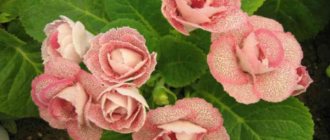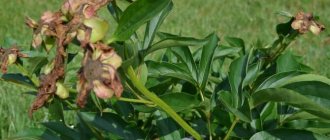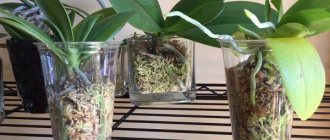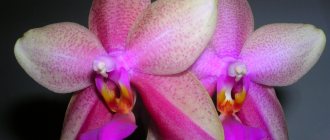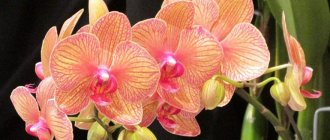What to do with the arrow?
In order for the orchid to continue to delight with its flowering, it is important to know what to do with the peduncle that remains after the plant has flowered. After it dries completely (it becomes yellow), it is cut off with a sharp tool. In this case, leave a stump of at least 1.5 cm in length. To protect the cut from rotting and pathogenic bacteria entering it, it is treated with wax.
Attention! The green part of the arrow is not cut off - the orchid will release a new one, spending a lot of energy. This is detrimental to the flower.
Features of cultivation
Any plant has its own preferences, and even more so for such a rare flower in our latitudes. The peculiarities of growing phalaenopsis are due precisely to the fact that they come from humid mountain and lowland forests, where they grow on trees, and therefore require a microclimate, which must be created artificially in our homes.
- Aphelandra at home: care and types
Here are some features of phalaenopsis:
- the pot and soil in which the phalaenopsis grows are required almost exclusively as support;
- Phalaenopsis roots should be in the air and in the light;
- Phalaenopsis roots are green, in nature they receive moisture and rainwater from the atmosphere, and food comes from the bark of the trees on which the flower grows. The roots participate in photosynthesis, so they must be exposed to light;
- In addition to ordinary roots, phalaenopsis has aerial roots that branch in constant search for food, so make sure that they do not climb into neighboring pots.
The succulent leaves of phalaenopsis, arranged in two rows, form a basal rosette. Peduncles are long, curved, butterfly flowers are collected in racemose inflorescences. The variety of colors is amazing: purple, lilac, white, yellow, green and red, brown... Often the lip of a flower stands out against the background of the petals (plain, tiger, mesh or striped) with a contrasting color. Phalaenopsis, like vandas and dendrobiums, are monopodial orchids, that is, they do not form bulbs.
The most pleasant feature of phalaenopsis is that they do not have a pronounced dormant period: their flowers bloom twice a year - in spring and autumn, although persistent flower growers achieve three blooms.
What to do next with a faded plant?
As soon as the phalaenopsis has bloomed, it is placed on a bright, warm windowsill, protected from direct sunlight. It is recommended not to apply fertilizers during this period ; watering should be carried out as usual.
Care will consist of the following activities.
Inspection
- Thorough inspection of the root system.
Dry and rotten shoots are removed with sharp pruning shears pre-treated in potassium permanganate. An antiseptic is applied to the cut itself. Healthy roots are gray or green. - The green mass is examined for the presence of spotting and other signs of disease. They get rid of them so as not to completely infect the entire plant.
Watering
Orchid is a tropical plant. It needs moisture and regular watering . However, after it has flowered, their number is reduced, give it the opportunity to rest and gain strength. This period lasts up to 3 weeks. After which, the usual mode is returned.
To determine whether a plant needs water, pay attention to the root system. If it is a rich green color, then the flower has enough moisture. Water when they turn gray.
The procedure is carried out as follows:
- Use soft (settled tap or filtered rain) water at room temperature.
- Saturate the plant until the roots turn green again.
- Phalaenopsis is watered using the immersion method.
Attention! After watering, the water is completely drained, even from the pan. Because this leads to the roots starting to rot.
Phalaenopsis responds well to a warm shower . To do this, place it in a basin and pour warm water directly from a watering can. Then blot the outlet dry to avoid water stagnation in it.
Top dressing
Fertilizers are applied to the orchid not only during the flowering period, but also after it.
For the plant to restore the lack of nutrients. In this case, the dosage is reduced by 2 times. Regular application of special compounds promotes the active growth of phalaenopsis and further abundant, bright flowering. Fertilizing is applied during every third watering . To do this, complex formulations containing:
- potassium;
- phosphorus;
- minimum amount of nitrogen.
The following fertilizers are suitable for orchids::
- Bona Forte;
- Mister-color;
- Kemira Suite.
They contribute not only to the growth of green mass, but also to the formation of buds. Before applying this or that fertilizer, the plant is watered abundantly.
Important! Fertilizers are applied strictly following the dosage specified in the instructions.
There are also compositions for foliar application . For example, "Doctor Folly". This is an aerosol that is sprayed onto the leaves. It stimulates the development of the peduncle and is a preventive measure against chlorosis and drying out of the leaves. Do not allow the composition to get on the flowers themselves, this will lead to their death.
After flowering, the amount of fertilizing is reduced during the plant's dormant period (about 3 weeks).
Temperature
The orchid prefers warm climates . The optimal temperature for it is:
- in summer 25°C;
- in winter - not lower than 18°C.
The difference between night and day temperatures (fluctuation of 5 degrees) stimulates the growth of phalaenopsis and the laying of new buds. However, prolonged lowering should be avoided, otherwise the leaves will begin to crack and dents will appear on them.
Fresh air is also beneficial. But they protect the flower from drafts .
Humidity
Comfortable humidity for an orchid is 50-70%. If the flowers dry out and fall off, and the phalaenopsis itself wilts and changes color, then the indicator is too low for it. This is especially true in hot summer or during the heating season.
To help the plant, humidity is artificially increased. Use wet expanded clay. An air humidifier or small containers of water that are placed around the flower are also suitable.
Lighting
Phalaenopsis is a light-loving plant. However, from direct sunlight he gets burns, which appear in the form of white spots. Diffused light is optimal for growing .
Attention! In a well-lit place, abundant and long-lasting flowering is achieved.
Lack of light is determined by the following signs:
- leaves stretch;
- turn pale;
- turn yellow;
- wither.
This is especially true in winter, when daylight hours are short. Daylight hours for phalaenopsis are 20 hours, regardless of the season .
In order for the plant to feel good, special phytolamps are installed for it. In summer, it is recommended to shade the orchid using a regular landscape sheet or a piece of plastic.
Duration of the dormant period after orchid flowering
The period from one flowering to another in phalaenopsis is called the dormant period. It can last for a different period of time, everything will depend on the condition of the trunk and its relationship to a particular variety.
Due to lack of lighting, the plant may practically not develop or grow in the autumn-winter period. You shouldn’t expect a flower stalk during this period either; it won’t have enough light from the window for normal development.
In most cases , it is the varietal affiliation that determines how long dormancy will last ; each has its own period.
Basically, the period between the appearance of flower stalks, if all care recommendations are followed, lasts a maximum of 6 months, but individual standards regulate these periods:
- The mini variety a dormant period ; the orchid grows actively throughout the year. The delay can only be caused by a reduction in daylight hours in winter. But for this, flower growers artificially “extralight” the orchids with lamps. The intervals between flowering range from 1 to 4 months, here everything will depend on care;
- the standard can rest for up to 3 months, and then again it will delight you with active flowering on the windowsill, which will continue for six months;
- the royal species will require a little more time to recover; the stem rests for at least 4 months, but there have been cases of earlier expulsion of peduncles;
- hybrid varieties have different indicators, everything will depend on which species were crossed and what the flower took more of. Basically, they manage to rest in 2-3 months with the proper microclimate and timely application of fertilizers.
Royal phalaenopsis rests a little longer between blooms.
But all this is conditional: if all the necessary conditions are created for the trunk, re-blooming may occur in a month.
Advice! It is not necessary to stimulate flowering in such a short time each time, otherwise the plant will quickly grow old and die.
Possible problems
After phalaenopsis blooms, a number of problems may appear:
- delay of subsequent flowering;
- wilting of leaves;
- drying out of the entire plant.
All of them are a consequence:
- location too bright;
- frequent, abundant fertilizing;
- trimming the flower stalk before it dries out;
- the arrow is removed too short (less than 1.5 cm).
Orchid is very demanding to care for. Therefore, it is worth paying special attention to it. As soon as signs of a particular problem are detected, it is immediately solved.
Diseases and pests, ways to combat them
Beautiful phalaenopsis, whose flowers are compared to bright butterflies, gets sick mainly due to improper care : excessive watering, dark room, inappropriate air temperature, etc.
Parasites also often bother the orchid. The most common are spider mites and thrips. For mild damage, a soap solution helps. In case of mass infection, fungicides will have to be used. Treatment is carried out once a week (3 procedures in total).
Although the plant is considered picky compared to other types of orchids, it still has its own characteristics. Taking them into account and following simple care techniques, the owner can easily achieve frequent and long-lasting flowering of phalaenopsis.
When and how should it be replanted?
Phalaenopsis is replanted no more than once every 4 years . There are a number of reasons for carrying out the procedure:
- rotting of the root system;
- compaction of the substrate;
- numerous aerial roots;
- unstable position of the plant in the pot;
- a large amount of green mass.
So, the compacted substrate is replaced with a looser one. To ensure that the root system receives sufficient oxygen.
Transplantation is carried out in spring or summer by transshipment . Proceed as follows:
- water the orchid abundantly;
- remove the flower so as not to damage the root system;
- transplant the plant into a new container with nutrient soil;
- the voids at the roots are not compacted so as not to injure the underground part;
- Watering is carried out no earlier than after 7 days, allowing the wounds on the roots to dry and heal.
Additional ventilation holes are made in the walls of the pot, increasing the flow of oxygen to the root system.
If it is necessary to completely change the substrate and cut off the roots (for example, they have begun to rot), then in this case the orchid is placed in the same pot.
Reference! They prefer transparent pots, this provides an additional opportunity to monitor the roots of the plant.
Below is a visual video about transplanting phalaenopsis:
https://youtu.be/OfGA761vzeY
With proper care, phalaenopsis will delight you with its abundant flowering for a long time. It is worth paying special attention to the plant :
- observe the temperature regime;
- maintain humidity;
- provide the orchid with the right amount of light and nutrients.
Then beautiful flowers will not keep you waiting.
Video on caring for orchids
Perhaps for some, maintaining and the entire process of caring for a Phalaenopsis orchid at home will seem complicated and time-consuming.
However, in practice it turns out that this is a rather unpretentious and hardy plant, despite the fact that it is very exotic. It is enough to take care of the air humidity, choose a place comfortable for the orchid and not get too carried away with watering. Your pet will enchant you for a long time with its flowers, so reminiscent of butterflies. You can also share your secrets for caring for a phalaenopsis orchid at home. If you have questions, ask them in the comments below, we will be happy to answer them.



